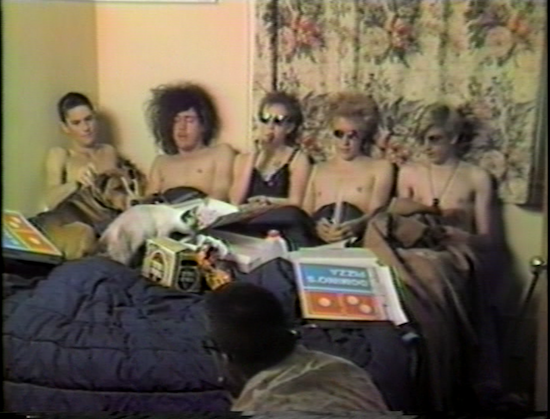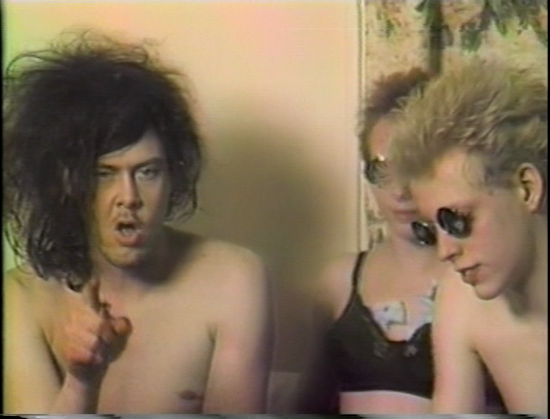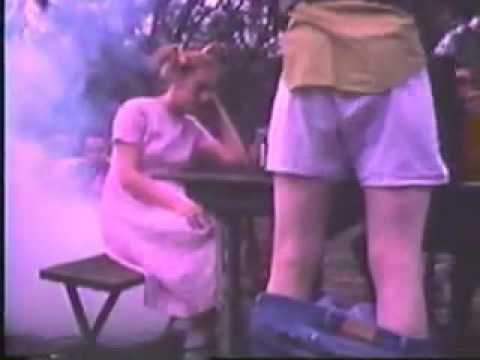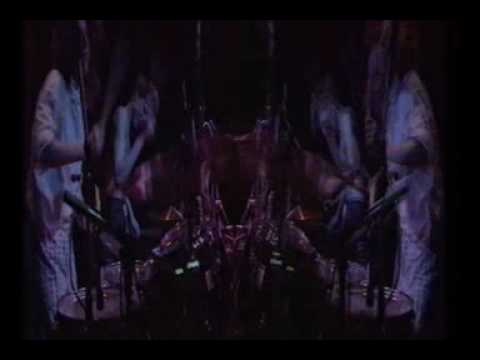For such a viscerally theatrical band, whose live shows blurred the line between music and performance art, The Butthole Surfers have a surprisingly small filmography. In fact, strictly speaking, it consists of just one eleven-minute short: the untitled, low-budget comedy-horror vignette known alternately as either Bar-B-Que Movie or Entering Texas. But within those eleven minutes, the Buttholes conjure a whole world of unhinged imagery, pointed references and unsettling (non) acting that conveys their essence more memorably and effectively than hours of mainstream Hollywood vehicles, high-concept music videos or diversions into serious sustained thespianism.
Bar-B-Que Movie was originally released in 1989 as part of Impact Video Magazine, a very turn-of-the-eighties attempt to envisage an edgy arts and music mag, available from record stores and other retail outlets, where every issue would come in the form of a VHS tape. Produced in New York, it was the brainchild of Stuart S Shapiro, who’d previously created the ground-breaking four-hour alternative arts magazine show Night Flight for the USA Network cable channel in 1981.
A key show in bringing alternative music and alternative comedy to a wider US audience during the eighties, Night Flight was originally cancelled at the end of 1988 (though it was subsequently revived), and Impact Magazine could be seen as an attempt to bring the same kind of programming direct to viewers without network interference, albeit in a streamlined 80-minute format.
Content included an interview with Public Enemy, Jane’s Addiction concert footage, stand-up from Bill Hicks, proto-Robot Wars performance art from Survival Research Labs, cult cartoons, and ‘Mondo Musto’ in which “celebrated Village Voice columnist Michael Musto looks at depravity in New York City and the world”.
In the event, only the one edition of Impact ever appeared, and it’s now something of a collector’s item, although the Buttholes’ segment can easily be found online. This was directed by recent film school graduate, jobbing actor and budding auteur Alex Winter, still one year away from becoming instantly recognisable as Bill S Preston, Esq. in Bill & Ted’s Excellent Adventure. Winter was also the onscreen host for Impact Magazine, and introduced Bar-B-Que Movie with a brief preamble that described it as the equivalent of an embarrassing family vacation home movie “provided your fat relatives happen to be The Butthole Surfers!”
While for the most part The Butthole Surfers were well-educated, middle-class kids from liberal family backgrounds, Bar-B-Que Movie played up their self-created image as depraved, inbred Texas rednecks in a loose parody of The Texas Chainsaw Massacre (1974). In his first film role, future Academy Award nominee John Hawkes (Deadwood, Winter’s Bone, The Sessions) starred as the hapless Jerry, driving into Texas on a family vacation with his wife and their young son, Jerry Jr. He’s the archetypal 1950s suburban dad, a repressed, mild-mannered innocent in a buttoned-up shirt and thick wire-framed glasses, whose only role is to be victimised by the violent locals he encounters, first on the crazy golf course and then at a “family-style barbecue” hosted by The Butthole Surfers themselves.
The film was shot at Austin’s abandoned, derelict Coxville Zoo. In this naturally creepy location, drummer Teresa Taylor stares near-catatonically at a portable TV showing the exploding head scene from Scanners on a loop, while a grunting, wild-eyed Gibby Haynes welcomes the family to their strange, smoke-wreathed ranch, looking for all the world like Disney’s Goofy gone horribly to seed. He pulls down his pants to add some “special grease” to the frying pan; as this forms the word ‘Satan’, Jerry Jr. runs off to explore and is tempted into a broken-down barn by drummer King Coffey, who is “preparing the meat”.
Back at the barbecue, Jerry and his wife are both offered “Scorpion tea” that turns out to be a powerful amphetamine-cum-hallucinogen. Jerry runs off to find his son, unaware that the hunk of meat he’s just helped himself to is in fact from his well-cooked offspring. Wandering into the old Coxville Grocery Market, he’s leered at by various stuffed animal heads before being bound in web-like cellophane and forced to watch as The Butthole Surfers materialise in a cloud of smoke onstage. In a section actually shot at the Ritz Theater on Austin’s Sixth Street, they perform the song ‘Fast’ with customary gusto, Gibby lighting a cymbal on fire while guitarist Paul Leary and bassist Jeff Pinkus gurn manically, riffing over Coffey and Taylor’s monotonous double drumming. Body-painted dancer Kathleen Lynch writhes hypnotically before Jerry’s horrified yet fascinated gaze. The final scene has Jerry come to his senses in a large outdoor cage, seemingly several days later, alongside his remarkably unperturbed wife. They’re served another portion of Jerry Jr. which Jerry happily and knowingly eats, only complaining about the menu’s lack of variety.
At the time, The Texas Chainsaw Massacre was seen as embodying the extreme, supposedly artless splatter horror movies that had found an audience via the 1980s home VHS market, decried and immortalised in the UK as “video nasties”. Though many of these films would later be reassessed as genre classics, back then they were commonly characterised as violent, immoral trash, likely to corrupt and deprave the undiscerning working-class audiences that enjoyed them. This cultural faultline of snobbery, moral panic and the intersection of capitalism and creativity was ripe for exploitation by both the Buttholes and Alex Winter, who likely saw referencing the home video horror market as a neat riff for their straight-to-VHS magazine project.
It was certainly a perfect fit for The Buttholes, who simultaneously celebrated and satirised blue-collar trash culture, gleefully rummaging through all manner of artefacts that were then widely dismissed as ugly, crude, tasteless or dumb, but which were nevertheless unironically used or enjoyed by millions of ordinary people. Call it punk, call it pop art, call it dada for its repurposing of overlooked, everyday items in a jarringly unlikely context, but everything from Kennedy assasination conspiracy theories to Black Sabbath and Julio Iglesias was grist to the Buttholes’ manic, acid-fried mill.
Bar-B-Que Movie allowed The Butthole Surfers to continue playing on how journalists and music fans in New York, California and elsewhere were only too ready to see Texans as dangerous, uncultured hicks. This isn’t to say that the band’s image as unwashed, drug-crazed, unpredictable purveyors of mayhem and madness was manufactured or untrue – far from it. But Bar-B-Que Movie marks the point where their reputation became solidified as mythology, there to be exploited even as the band transitioned into a more professional and perhaps less exciting incarnation as the nineties began.
Impact Video Magazine also featured a report on house music from Snub TV, the acclaimed, UK-produced independent music showcase that was a part of Night Flight from 1987-1988, and which was subsequently picked up by BBC2 for three further series from 1989 on. The third episode of the first BBC season featured The Butthole Surfers working in their home studio, as well as performing ‘Jimi’ live at Harlesden’s Mean Fiddler in early 1988. This was their first UK TV appearance; in the US, that honour went to New York public access cable programme The Scott And Gary Show, where they’d played six songs and given a chaotic interview as far back as 1984.
Teresa Taylor left The Butthole Surfers in mid-1989, citing exhaustion, mental health problems and an overwhelming fear of flying. Almost immediately afterwards she became part of the large ensemble cast of Slacker, filmed by director Richard Linklater on the streets of Austin that year and premiering in the city in July 1990, before going on general release in 1991. The $23,000 independent film would become a major cult hit, seen at the time as defining a generation and going on to inspire and influence the next decade of independent film-making, most notably Kevin Smith’s Clerks and, in its non-linear style and conversational, pop culture-referencing dialogue, the early films of Quentin Tarantino.
Although, like most of the cast, Taylor has just the one scene in Slacker, her performance as ‘Pap Smear Pusher’ is one of the film’s most memorable set pieces, and posters for the film featured a psychedelic close-up of her character. Attempting to sell a vial supposedly containing Madonna’s smear test to a couple of acquaintances she runs into on a street corner, her breathless hipster sales pitch satirises both celebrity culture and the gullibility of conspiracy theorising, Gen X stoners. To date it’s Taylor’s only film role, a shame as her natural, off-beat charisma communicates well to the camera. The Butthole Surfers are among several Austin bands featured on Slacker’s soundtrack, with the doomy, haunting ‘Strangers Die Everyday’ playing over the end credits.
As well as hanging out with Hollywood stars like Johnny Depp and River Phoenix, Gibby Haynes had a series of bit-part roles in major films throughout the nineties, beginning with an uncredited cameo in Alex Winter’s flawed cult classic Freaked (1993), one of the most bizarre and unlikely ventures ever to be bankrolled by a major studio. Freaked began life as a full-length vehicle for The Butthole Surfers, with Gibby, Winter and Winter’s writing partner Tom Stern working up the original idea at around the same time as Bar-B-Que Movie, expanding on its themes and envisaging a demented gonzo horror flick that could be made for around a hundred thousand dollars. Pitched as “Beach Blanket Bingo meets The Evil Dead”, and with the support of Sam Raimi, it still failed to find studio backing. In the wake of Winter and Stern’s successful 1991 MTV sketch show The Idiot Box, the script was completely rewritten as a surreal, Mad Magazine-style comedy, with the Butthole Surfers element dropped entirely.
At a live Q&A following a 2012 screening of Freaked at 92Y Tribeca in New York, Alex Winter told the AV Club’s Alison Willmore how he, Stern and Gibby set out to write a Butthole Surfers movie. “It was a hard R-rated totally insane [script], where a family stops off at a roadside barbecue and they all get turned into freaks,” he remembered. “We had different kinds of freaks. We had a human bong. It was all Buttholes music but we couldn’t get it sold.” In desperation , they pitched the film to the head of Twentieth Century Fox as “a mainstream comedy with freaks, just like Bill & Ted, but not at all” and to their surprise were offered a $12m budget. They then wrote a completely new script in a single night to meet the studio’s expectations.
Even this suffered multiple compromises, with heavy cuts and the original title of Hideous Mutant Freekz vetoed at the last minute (although a song of that name still plays over the end credits, performed by Parliament-Funkadelic). Despite their substantial financial investment, Fox got cold feet after test screenings found the film “too weird” and the studio pulled all promotion and distribution, resulting in a box office flop that effectively went straight to video.

Alongside a cast that includes Winter, Randy Quaid, Mr T and Brooke Shields, a wild-haired Gibby gets one line as a member of the freakshow audience while, in a further link to Bar-B-Que Movie, an unrecognisable John Hawkes plays the mutant Cowboy from beneath a prosthetic bovine head (also unrecognisable, and like Gibby uncredited, is Keanu Reeves as Ortiz the Dog Boy). The Butthole Surfers contributed ‘Sweat Loaf’ and exclusive track ‘Butter Queen’ to the soundtrack, while Paul Leary provided a bespoke instrumental, ‘Gumby Jack Flash’. Fox cancelled the planned soundtrack LP release but it finally saw the light of day last year on vinyl, courtesy of Death Waltz Recording Company.
Gibby’s friendship with Johnny Depp led to him appearing as ‘Man with Gun in Alley’ in Jim Jarmusch’s 1995 “psychedelic western” Dead Man, and the pair co-directed a short film about guitarist John Frusciante, The Stuff in 1993. In 1997, Gibby played party host Jujyfruit in Gregg Araki’s Nowhere, and made an uncredited appearance in Depp’s The Brave, which also starred Marlon Brando. In the noughties he became something of a go-to talking head in documentaries on outsider musicians such as Roky Erickson, Daniel Johnson and The Flaming Lips, and appeared as himself in a trio of UCB comedy shorts in 2008. In 2016 and 2019 he starred in two short films written and directed by Peter Bolte, Walden Pink (with The Jesus Lizard’s David Yow) and Hey! Aren’t You Garrett Crest?
Gibby was already an experienced screen actor by The time the Butthole Surfers formed in 1981, and it could be said that in his chaotic, theatrical stage performances he was merely carrying on the family business. His father, Jerry Haynes, was known to millions of young TV viewers as Mr Peppermint, and a prepubescent Gibby was among the local children recruited as ‘Gumdrops’ to appear on WFAA-TV’s early-morning Mr Peppermint Show throughout the sixties. Gibby was a born entertainer, learning to love the limelight and picking up physical clowning and slapstick skills that would serve him well in his future career.
When Gibby and Paul Leary formed The Butthole Surfers at San Antonio’s Trinity University they were both interested in confrontational, absurdist performance art as well as punk. Early shows included mangled covers of TV themes like Mannix, The Brady Bunch and Perry Mason alongside food fights, props, pyrotechnics and nudity. The Buttholes were made to be filmed, and in 1986 Touch And Go released the Live VHS Blind Eye Sees All.
In this video, two Detroit shows in early ‘85 are cut together with scant regard for continuity, and interspersed with interview sequences of the band in a pizza-strewn bed together. Gibby’s free-flowing, surrealist raps are an art form in themselves, and the tape is also notable for being the only official documentation of Trevor Malcolm’s time playing bass (and sousaphone!) with the group. Coffey and Taylor’s possessed double drumming is particularly impressive, and the film captures the lunatic DIY chaos of the early band, even though the audience look completely bemused.
At this point The Butthole Surfers’ live show hadn’t yet evolved into the multimedia sensory overload of a year or so later, but the sets captured on Blind Eye Sees All are still a masterclass in what can be achieved with a few clothes pegs, a toilet roll and a stuffed shirt mannequin. The band would soon begin to incorporate films onstage, their collection initially facilitated by Teresa Taylor being a Radio, Film and Television major at Austin’s University of Texas. This gave her access to UT’s 16mm film library, and the band grabbed the most graphically violent, sickening or weird footage they could lay their hands on. Extreme medical procedures were a particular favourite, with UT soon getting requests from a Dr Haynes for surgery films (while a student himself, Gibby had produced a zine entitled Strange VD, featuring medical photographs of deformities, gruesome injuries and skin conditions, all captioned as fictitious diseases like ‘taco leg’ and ‘pinecone butt’).
Soon fans (including the band Coil) began sending the Buttholes the sickest videos they could find through the mail, and the band gleefully employed these alongside old cartoons and episodes of Charlie’s Angels. Film of farming accidents and, most notoriously, penile reconstruction surgery were slowed down, played backwards and cut up for maximum effect, deployed alongside massed strobes and smoke so that the films often seemed to come off the back wall and move towards the audience, projected directly onto the banks of fog rolling off the stage. Add in the band’s own antics, the deafening volume of distorted guitars and drums, plus the fact that a large portion of the audience and band at any given show would be wildly tripping, and you have a multimedia experience that makes The Grateful Dead and Ken Kesey’s infamous Acid Tests of the 1960s seem like a quiet Sunday afternoon watching Songs Of Praise with a small sherry.
Not all The Butthole Surfers’ cultural references could be considered trashy. Their obsession with Garry Shandling went back at least as far as 1991, when Gibby repeatedly chanted the comedian’s name on ‘Revolution’ from that year’s Piouhgd LP. It peaked with 1996’s ElectricLarryland, an album title that punned on Hendrix’s Electric Ladyland much like 1988’s Hairway To Steven spoofed Led Zeppelin. But it also referenced Shandling’s latest TV vehicle, The Larry Sanders Show, and after the album spawned a genuine hit single in ‘Pepper’ the Buttholes were invited to appear on the programme, which they did in the January 1997 episode entitled ‘The Prank’.
Performing ‘Ulcer Breakout’ on the chat show-within-a-show, the Buttholes were shown inviting Sanders/Shandling to hang out with them afterwards, though onscreen at least he declined their offer. ElectricLarryland was as close as The Butthole Surfers got to mainstream success, with the album reaching #31 and going gold, while the video for ‘Pepper’ became an MTV staple, alongside ‘Who Was In My Room Last Night’ from their previous album, Independent Worm Saloon. Not bad for an album that, until Capitol Records insisted on a name change, the band were going to call Oklahoma! Maybe The Butthole Surfers were just tireless exponents of musical theatre all along.
Ben Graham is the author of Scatological Alchemy: A Gnostic Biography Of The Butthole Surfers, published by Eleusinian Press




